Ilkeston - The Trees
Of Victoria Park
w/e 20 September 2009
All this week's pictures were taken
with a Kodak DX6490

Since uploading Part 01 of this series I have resolved
the discrepancies between the numbers shown on a Council leaflet
and the information posts adjacent to the trees in the park.
See the Introduction for more.
Part 02 - On the Bristol Road side (Top half)
Bristol Road forms one side of the triangle of roads around Victoria
Park and runs from the junction with Drummond Road downhill to
its junction with Manners Road. There are eleven notable trees
on this side of the park and in this part we will concentrate
on six of them towards the top end of the slope.
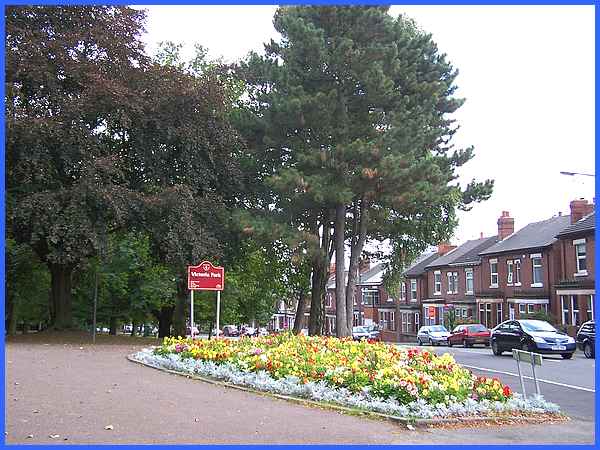
Originally the park was bounded by cast iron railings and access
gates but now access is possible at all points of its perimeter.
We'll begin this part though with a view over the welcoming flowerbed
down Bristol Road at the main Drummond Road/Bristol Road entrance.
|

Slightly to the left of the Bristol Road view is the first tree
of note in this section. From here on, I will add an identification
to each tree in the format (L-/P-) where L refers to the leaflet
number and P is the identification post number. This first tree
then is a Copper Beech (L-/P7) and shows the first discrepancy
between the two as it is not mentioned on the leaflet. The Copper
Beech is a cultivar of the Beech tree which means it is a cultivated
plant that has been selected and given a unique name because
of desired characteristics, in this case the purple coloured
leaves. It is a deciduous tree that can grow up to 40m high.
|
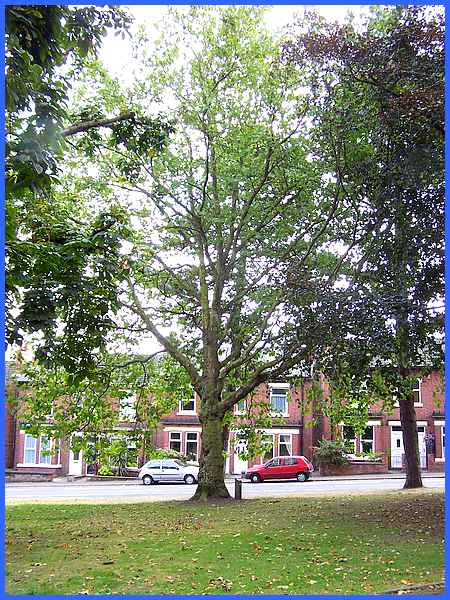
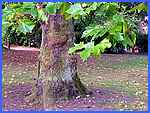 Following
a path through the park, the next tree of note to be identified
is a London Plane (L7/P8). The variety of the Plane tree took
the name London from the fact that it was planted in the streets
and parks of the capital about two hundred years ago. The London
Plane is noted for having a smooth bark and where patches of
the bark peel off, it displays a camouflaged appearance. In this
particular example of a London Plane in Victoria Park this was
not particularly evident (left). London Planes are also responsible
for allergic reactions in some people due to hairs that are shed
by both the leaves and bobble like fruit. Following
a path through the park, the next tree of note to be identified
is a London Plane (L7/P8). The variety of the Plane tree took
the name London from the fact that it was planted in the streets
and parks of the capital about two hundred years ago. The London
Plane is noted for having a smooth bark and where patches of
the bark peel off, it displays a camouflaged appearance. In this
particular example of a London Plane in Victoria Park this was
not particularly evident (left). London Planes are also responsible
for allergic reactions in some people due to hairs that are shed
by both the leaves and bobble like fruit.
|
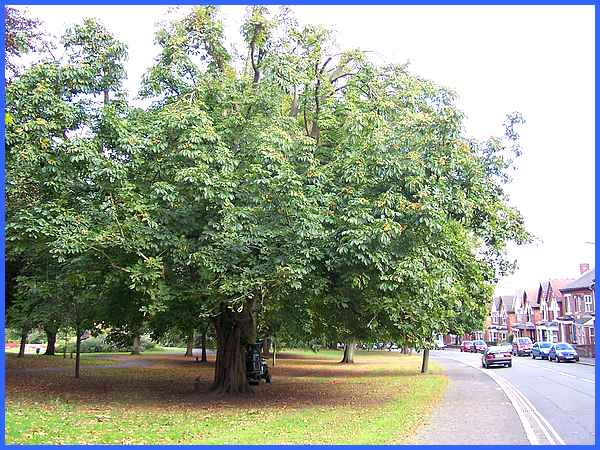
Our next tree is probably one of the most easily recognisable
especially by every schoolboy in the land. The Horse Chestnut
(L8/P9) which produces clusters of fragrant flowers in the early
summer that are often referred to as candles was introduced to
Britain in the seventeenth century.
|
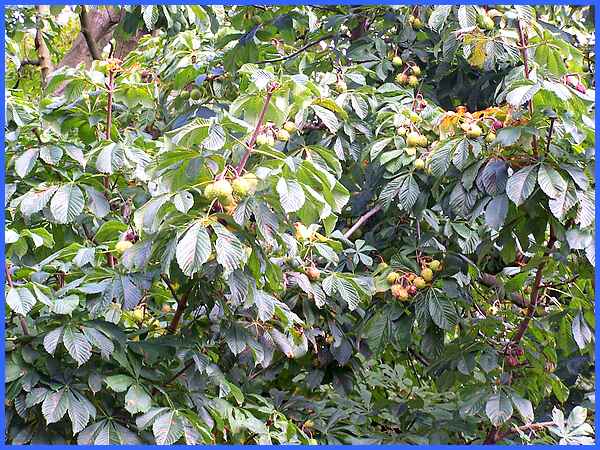
But it is even more well known for its spiny autumn fruits known
as conkers. The game of conkers evolved from a game called conquerors.
This was originally played with snail or conch shells, conch
being the French word derived from the Greek for any kind of
shellfish or their shells. Each October the World Conker Championships
are held at Ashton in Northamptonshire and are hosted by the
Ashton
Conker Club.
|
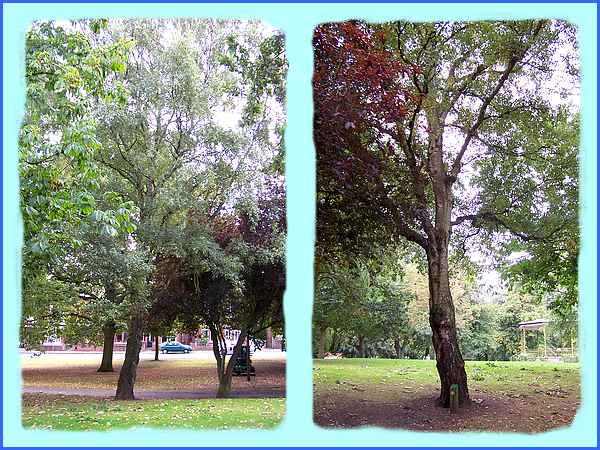
Another easily recognisable tree from the colour of its bark
is the Silver Birch (L-/P10) evident above in the right hand
picture of the tree. The left hand picture is the same tree seen
from the opposite side. Interestingly the Silver Birch is the
national tree of Finland and occasionally boughs of the tree
are used in saunas to beat oneself - presumably by Finnish masochists.
|
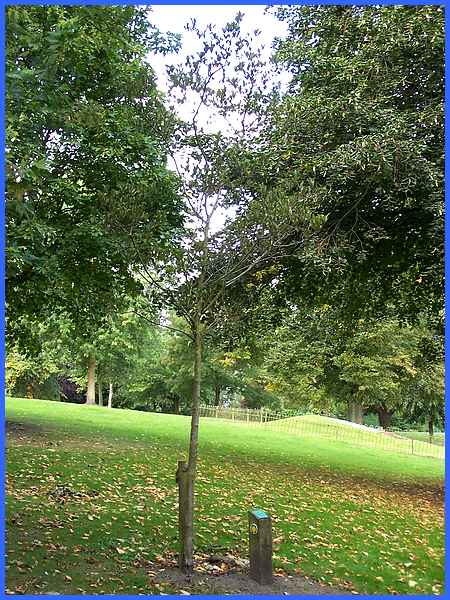
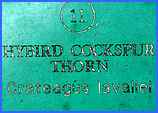 At only 6m high when
fully grown the Hybrid Cockspur Thorn (L9/P11), a member of the
Hawthorn family, is one of the smallest trees in Victoria Park
and this example is only about one third of that height. Situated
where it is and surrounded and somewhat overshadowed by neighbouring
trees made getting a decent photo of it difficult. It may be
easier when the glossy green leaves turn dark red as we get further
into autumn or in spring when covered with attractive white flowers
but I don't suppose the engraved plaque (right) on the information
post that states that the tree is "Hybird" will change
soon. At only 6m high when
fully grown the Hybrid Cockspur Thorn (L9/P11), a member of the
Hawthorn family, is one of the smallest trees in Victoria Park
and this example is only about one third of that height. Situated
where it is and surrounded and somewhat overshadowed by neighbouring
trees made getting a decent photo of it difficult. It may be
easier when the glossy green leaves turn dark red as we get further
into autumn or in spring when covered with attractive white flowers
but I don't suppose the engraved plaque (right) on the information
post that states that the tree is "Hybird" will change
soon.
|
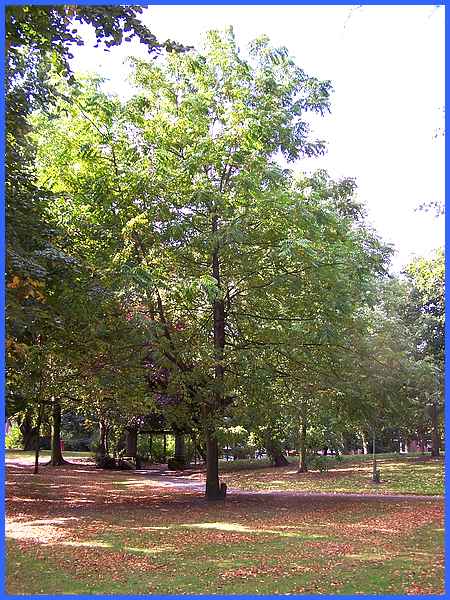
You may have noticed in a couple of the previous images that
the grass was being mowed whilst I was taking the photos and
regular mowing is essential to prevent the final tree in this
section from spreading as it is known for 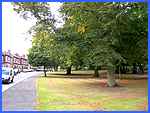 producing suckers from its roots. It is a
fast growing tree that secretes allelopathic chemicals preventing
other trees from growing nearby and is called the Tree Of Heaven
(L10/P12). I don't recollect ever having smelled burnt peanut
butter but apparently that is what the attractive leaves and
flowers of this tree resemble. producing suckers from its roots. It is a
fast growing tree that secretes allelopathic chemicals preventing
other trees from growing nearby and is called the Tree Of Heaven
(L10/P12). I don't recollect ever having smelled burnt peanut
butter but apparently that is what the attractive leaves and
flowers of this tree resemble.
At this point we have reached the approximate halfway point down
Bristol Road (right) and will will return in October to continue
to the Manners Road junction.
|

